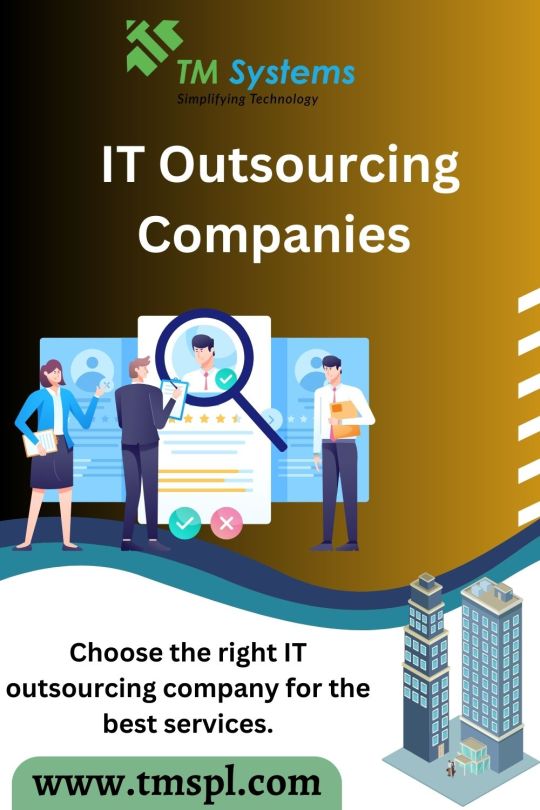#itoutsourcingcompanies
Explore tagged Tumblr posts
Text
Leading IT Outsourcing Companies In India

Currently, India is the leading IT Outsourcing service provider with affordable costs. If you are looking for custom software development, mobile app development, or digital transformation, these companies offer unparalleled expertise. To select the best IT Outsourcing Company in India, you have to Evaluate the company’s expertise, client reviews, technology stack, and pricing structure.
0 notes
Text
Business Outsourcing Services | Rio Business Solutions
Looking for a business outsourcing partner? Rio Business Solutions offers a wide range of services to help you with your business needs.

#businessoutsourcing#businessprocessoutsourcing#outsourcingcompany#outsourcingservices#businessprocessservices#businessprocessoutsourcingcompanies#itoutsourcingcompanies
0 notes
Text
Why do businesses outsource their IT needs?
In a world of ever-evolving tech, why is it important for businesses to outsource their IT needs?
Attention business owners: This is your chance to move ahead of the game. Find out how engaging an #ITteam that specializes in your particular industry can give you an extra edge.
Tap the link below to read in detail why outsourcing #IT is essential for every company's success - and what other benefits you can reap! bit.ly/3nhjt3D


#Businesses#smallbusinesses#smallbusinessowners#itneeds#itoutsourcing#itoutsourcingcompany#outsourceit#businessowners#startups#outsource#outsourcebusiness#businessowner#supportsmallbusiness#softwaresolutions
2 notes
·
View notes
Text
IT Outsourcing and ODC Solutions

We provide top-notch IT Outsourcing and ODC solutions, empowering businesses with cost-effective, scalable, and expert-driven tech services to accelerate innovation, streamline operations, and achieve sustainable growth. Partner with us for seamless digital transformation!
0 notes
Text
Hire IT Services Outsourcing Companies

IT services outsourcing companies provide a range of services, including software development, application maintenance, help desk support, data center management, and cybersecurity. These companies help businesses reduce costs, improve operational efficiency, and access specialized expertise.
0 notes
Text







These popular app monetization methods can transform your success story. 💡💸 Elevate your app game and your earnings! #AppWealth #appdeveloper #itoutsourcingcompany #appdevelopement
0 notes
Video
youtube
Say Goodbye to Hassles: Your Ultimate Guide to a Seamless IT Outsourcing Company Hunt!
🌟 Ready to revolutionize your business with the right IT Outsourcing Company? Dive into the ultimate guides that cover every crucial factor you need to consider. From communication strategies to transparent pricing models, you'll discover the blueprint for a successful tech partnership. 🚀 Key Points: Lock Down Communication Plans Check Referrals and Reviews Compare Pricing Models Start Small for Big Success Implement Strong Governance Don't miss out on this essential knowledge that can elevate your business to new heights. 💼💡 Source Article: Read Part 2 - https://bit.ly/3KKS5E4 Missed Part 1? Dive into the foundational steps that set the stage for success! Learn more: Read Part 1 - https://bit.ly/47sBa2G #ITOutsourcingCompany #TechPartnership #BusinessGrowth #TechSuccess #InnovationSolutions #DigitalTransformation #ITConsulting #OutsourcingStrategies #EfficiencyBoost #TechCollaboration #BusinessOptimization #CostEffectiveTech #DigitalExpansion #StrategicPartnership #ITServices #TechExpertise #OutsourcingBenefits #ITIndustry #FutureOfTech #GlobalOutsourcing #TechEmpowerment #DigitalEconomy #InnovativeSolutions #EnhanceProductivity #ITInnovation
1 note
·
View note
Text
Best IT Outsourcing Company for best Services & Consulting in USA

As a leading IT Outsourcing Company, Techahead offers premium IT outsourcing to companies throughout USA. Our outsourcing company understands that many businesses in the area rely on the effectiveness of their technology management to support their daily operations. For more details ping us today and schedule a call.
#IToutsourcing#IToutsourcingcompanies#ITdevelopmentoutsourcing#ITOutsourcingFirms#IToutsourcingcompany
0 notes
Text
Best IT Outsourcing Companies in India

Currently, India is the leading IT Outsourcing service provider with affordable costs. Whether you're looking for custom software development, mobile app development, or digital transformation, these companies offer unparalleled expertise. To select the best IT Outsourcing Company in India, you have to Evaluate the company’s expertise, client reviews, technology stack, and pricing structure.
0 notes
Text
Why choose an IT outsourcing company?
Today, more than ever before, every business organization needs a strong IT infrastructure. With most people working from home or remotely, a business can perform the best only with a dependable and solid IT ecosystem. If your time and budget are constrained, you can look at going in for a reliable IT outsourcing company.
What are the benefits of outsourcing IT to a third party?
Cost control – one of the reasons why many companies go in for outsourcing IT functions. In-house teams need to be paid salaries and benefits, while outsourcing will save on salaries and perks. To top it, the third-party service provider will have a well-built infrastructure, which means that you do not have to fund IT resources other than those required to run operations smoothly.
Skilled professionals from around the world You can choose to outsource from three models – offshore, onshore, and nearshore. Outsourcing gives companies access to talent across the world – the talent that would cost way too much if companies had to hire in-house. For example, organizations in the US with engineering projects can outsource engineers from IT engineer resource providers in India. India is known for being home to highly skilled engineers who can work on projects at very cost-effective rates vis-a-vis rates that engineering staff would demand in the US.
Minimizing risks The outsourced partner is responsible for IT compliances, which helps business minimize their risks. In most cases, the IT outsourcing company works as a partner and hence is equally responsible for ensuring that the projects are carried out compliant with all safety aspects
Businesses often choose to go in for Managed Services Outsourcing in Delhi because it helps them focus on their core activities without being hassled about IT infrastructure. Going in for Managed services is a better option than outsourcing as in the former, service providers offer end-to-end functional support.
For Original Post Visit: https://it-outsourcing-services-company.blogspot.com/2021/10/why-choose-it-outsourcing-company.html
2 notes
·
View notes
Text
Getting the best IT outsourcing services in Denmark is more than just a strategic move; it's an investment in the future success of your business. In this blog, we explore the compelling reasons why you should consider hiring the best IT outsourcing company in Denmark.
0 notes
Text
Roles and Responsibilities on a Software Development Project
When starting a software development project, we want our team to consist of experienced and skilled individuals, professionals who know all the ins and outs of their craft. But hiring good specialists doesn’t necessarily mean they will form a good team or establish a truly effective software development process.
Pre-development
Before your developers write the first line of code for your future product or service, there is still a fair amount of work and thought to be put into your project. From initial meetings with your vendor to planning and understanding what it is that you’re all trying to produce here, this section will introduce you to the key people you meet during the discovery phase of your software development project, before the contracts get signed and the development truly takes off.
Account Manager
Account managers play a crucial role in any B2B relationship. And software development outsourcing is no exception. The account manager is the first person you meet when you approach a software development company with a project you need help implementing. Account manager responsibilities include building and maintaining a healthy, long-term relationship between the client and the outsourcing vendor they represent. They will also serve as your client success manager after the vendor’s part in your project is over: check in on the health of your business, the software product or service their company helped you build, and handle all of your further requests.
The account manager is your main point of contact with the vendor. They are there to understand what it is that you’re looking for and where you’re trying to go with your business needs. They will analyze your request and guide you through the presale process, making sure you get all the information and resources your project requires.
As an output from this initial phase, the account manager will provide you with two key documents:
An estimation document that is broken down into approximate costs, timelines for the project, and terms and conditions, clarifying details such as payment options and collaboration models.
A proposal document that walks you through the tech and business approach your vendor has chosen for the implementation of your project, including the outline of inputs and outputs expected from both the client and the vendor.
These documents will help you get a rough idea of the processes your vendor is trying to organize for your project, the team they’re putting together, the potential risks and assumptions involved, and finally where exactly all those costs are coming from. Soon after you’ve received the aforementioned documents, your account manager might follow up with a call to talk you through them with answers to all of the questions on the estimates and why some of the rationales were made.
Business Analyst
When you’re happy with the estimation phase, you might want to move straight to development. But such transition would require you to be certain that you can successfully achieve your business goals with what you have on your mind. And this would be the case if you had all of your business analysis, technical requirements, and other documented project data ready from the start. In our experience, however, most of the clients don’t really know what exactly they want to build straight away. So we move into the discovery phase instead, to help them figure it all out before the full development team is assembled.
A good discovery phase is a critical part of your software development process. Here, you’re laying the groundwork for the success of your software solution. This may take anywhere between a few hours or a few weeks, depending on whether it’s a big, complex solution or a small project.
One of the first people you meet in the process is a business analyst. Quite often overlooked, unfortunately, this is one of the most valuable roles in your development environment. But what does a business analyst do?
Their main job is to polish and verify your business idea so that you can be sure you’re not wasting your time and money building something your stakeholders neither need, nor want. A business analyst takes you through the outsourcing vendor’s understanding of your business needs and highlights where those could be refined or even expanded. With a data-oriented mindset, business analyst’s assumptions and suggestions are always supported with comprehensive data.
In the course of the discovery phase, together with a software architect, delivery manager, and possibly even a UX/UI designer (roles we will get to shortly), a business analyst defines and further refines the features your software solution should have from a business perspective. They translate your business needs to requirements, help you craft a product vision, and make sure the technical side of things is going in the right business direction—towards achieving the project’s product/market fit.
The key deliverables a business analyst provides are:
Business Requirements Specification which includes data such as a problem statement, business drivers, business model, business use cases, and other business requirements.
Functional Specification that is the collection of all the functional requirements and features for the product such as system use cases and user needs.
Non-Functional Specification that provides requirements for the future product’s performance, security, maintainability, compliance, and other non-functional requirements.
The key responsibilities of a business analyst include:
collaborating and leading effective communication with all stakeholders to identify opportunities and potential benefits for the project and meet the user needs
creating documentation, formulating goals, and building business architecture to meet quality requirements
making sure project outcomes are aligned with the product vision, business model, and strategy.
Software Architect
Some clients come to us when they have absolutely no idea of the technology they want to use in their software development project. And that’s okay!
So, we need to put someone in front of them who knows what tech would complement their business requirements best. This person is called a software architect—the technical brains of the operation.
Proper software architecture is crucial when it comes to high-quality projects. The key responsibility of a software architect is to define the best architectural structure, the software’s model and function for your project. They will reduce technical complexity and provide technical leadership for your project, focusing on clarity. They are in charge of all the high-level design choices on the project, including the coding standards, environments, tools, platforms, etc.
Where a Senior developer would be enough to handle the tech matters on a small project, you definitely need to involve an experienced software architect on a big project with complex non-functional requirements to solve. Even when you already have a tech stack on your mind, they may still suggest different, better-suited technologies and solutions based on non-functional requirements to potentially save you money and time.
Last but not least, a software architect will provide you with a comprehensive system design document as part of the discovery phase. An architectural document that shows you exactly how the vendor plans to put together your solution—design and programming guidelines, iteration contents, and a collective understanding of what the client needs from the tech solution and environment as a whole.
Delivery Manager
Shortly into the discovery phase, you will be introduced to another key figure called a delivery manager. This fundamental role in the Agile software development environment is accountable for the management of your expectations, overseeing the delivery process from discovery to deployment, and ensuring that your needs are met in a timely fashion. This is the person in charge of coordinating the presale and discovery phases and serves as your main point of support and escalation throughout your software development project.
A delivery manager effectively understands what the client needs not just from a technical perspective but based on how the client is going to drive their business with it as well. They are there to help you understand exactly what it is that you’re after.
For example, a client might want to implement a transformation project to reorganize their business in order to either save money or effectively grow in a particular direction. A delivery manager can add value because they understand both the business and the technical element of the problem the client is trying to solve. They will identify the best processes or delivery methods to use, provide the client with the data they need to make informed decisions, and help them measure and evaluate outcomes. In case the project faces a challenging obstacle, the delivery manager will integrate various team efforts to remove the blocker, maintain delivery momentum, and get the best value within these constraints.
Among the aforementioned duties a delivery manager performs, the broad range of their responsibilities includes:
maintaining proactive and reactive communication with the business owner and stakeholders to interpret their technical and business needs, facilitate difficult discussions, and provide delivery confidence
setting up the environment your development team needs to ensure efficient collaboration, communication, and focus on achieving project goals
bringing people together to form a motivated team, protecting team members, and facilitating the delivery flow with an iterative plan to work towards
coaching the team to help them become more autonomous, better at organising their own work
proactively addressing all the internal and external risks, issues and dependencies with budgets and people
driving experimentation and continuous improvement with the most suitable agile practices and tools for the project
Domain Expert
During the discovery phase, your business analyst may suggest involving a domain expert or, as they are sometimes called, a subject-matter expert. These people are true professionals with deep knowledge, broad skills, and extensive experience in a particular industry or business area. Like, for example, an accountant is an expert in the domain of accountancy. The input from such experts can save you a lot of back and forth on refining requirements.
Domain experts serve as consultants to your software development project. Their superior knowledge of the domain helps your software development team create a higher-quality software product vision statement during discovery and verify if the business and technical requirements were met in full during user acceptance testing.
Although domain experts usually lack any kind of technical expertise, this should be considered a strong point. The lack of technical knowledge helps them focus purely on business outcomes, which provides your team with deeper insight into the problem you’re trying to solve. They can also prove a great contribution to the creation of your early-stage wireframes and prototypes.
Development
A lengthy but less complicated process than discovery and planning, the development phase is where the actual coding starts and you get tangible results of what you’re actually paying your vendor for. The process is pretty straightforward: from iteration to iteration, the coding and related tasks are divided between software development team members according to their area and level of expertise.
Project Manager
Moving from the discovery to delivery phase, your software development company sources, interviews, and onboards the required talent to your project. The hiring process is usually coordinated by a dedicated software project manager who makes sure all the candidates are handpicked to best suit your project goals.
But before we dig into the role of a PM and their responsibilities on the project, you should learn about the two important documents a project manager provides you with prior to the development stage:
A project initiation document a.k.a. a project management plan is a document that defines how the client and the vendor will manage communication, the roles and responsibilities on the project, as well as the risks, issues, quality control, change control, etc. The document acts as an engagement between the two companies and provides insight into the escalation process between the two.
A work breakdown structure organizes and defines the total scope of the project. It tells the client what needs to be built, why, and gives them full transparency into the development processes. The document includes information about work on each of the features, associated technology stacks, and costs broken down by each and different elements.
Back to responsibilities now. Simply put, a project manager is a person responsible for keeping your product delivery on track and within budget. In comparison to the role of a delivery manager, your PM is more focused on micromanaging the team. They manage every development process directly, coordinating the team in accordance with the agreed software development practices and approaches. They continuously assess the performance of the project and each individual team member to introduce process improvements that would enable faster and higher-quality iterations. The goal is to keep the team members high-performing and provide everything they need to get the work done.
Among the key duties the project manager performs are also maintaining frequent and consistent communication with the client and ensuring a good working relationship. The PM manages meetings and documentation, identifies and monitors risks. When something unexpected happens in the course of development, their job is to solve the problem and ensure it doesn’t reappear in the future. Having an experienced project manager to rely on, you no longer need to keep track of every little activity on the project and can focus entirely on your business instead.
UX/UI Designer
Although we’re introducing you to the role of a UX/UI designer here in the development section of the article, it is quite likely you have already met this person during the presale and discovery phases. The UX/UI designer is responsible for turning your product vision into a compelling, friendly, and intuitive user interface that provides great user experience and brings high conversion rates. Their focus is set on product usability, functionality, and visual design.
More often that not, the UX/UI designer joins the project prior to the delivery phase, providing you with the following:
A general design approach, a design philosophy that serves as a kind of a guide that explains the goals and the overall design direction for your product in line with the work of your business analyst. This also usually means well-defined screens and user stories ready for the first sprint.
A flowchart, a diagram or visualization of user steps and screens that make it easier for the client to understand the future structure of the product.
Wireframes, the basic structure of your future product with more detailed depiction of user journeys and layout of content and functionality. They help provide better estimates for the project and define the main tasks.
A clickable prototype that serves as a full visual representation of the user interface of the future product. And unlike static wireframes, a clickable prototype may include all the animations, transitions, sliders, as well as other effects and functionality. A good prototype can sometimes even be visually indistinguishable from a finished product.
When it comes to product development, designers play a very important role in the process. Especially in the early stages, helping the client better understand how exactly their product will be working and making it easier for them to convey ideas to their stakeholders and raise money.
Even though this means less profit for the vendor in the short term, this provides significantly more value to the client and serves as a great foundation for a long-term, trustful relationship. When the client does secure that investment, they are more likely to bring further product development to the company that has already shown their reliability with deep expertise and budget-friendly solutions.
The key duties of a UX/UI designer include:
working closely with the business analyst and software architect to transform business ideas into mockups and prototypes
establishing design patterns and iterating them using a variety of design approaches and prototyping methods
designing intuitive end-to-end journeys and interactions that help users complete their goals with ease and enjoy the process
creating layouts and individual design elements that underpin interactions and ensure visual attractiveness of the product
communicating ideas to the development team and other team members throughout the build process to ensure everyone stays on the same page
Your UX/UI designer is one of the key players responsible for the success of your product. So never assume that they do all their work up front and then move onto another project. No matter how little design work your product or service requires, the UX/UI designer will be actively involved throughout the entire delivery process from translating your business goals and ideas into clickable prototypes to supervising feature implementation, assessing feature design performance, and introducing the necessary UI fixes over time.
Software Developer
Software developers, also referred to as coders, are your main and indispensable troops on a software development project of any complexity and scale. Their role on the project is pretty straightforward: writing and implementing clean, efficient code based on the provided technical requirements. It wouldn’t hurt to mention that the more effectively the management communicates the technical requirements to your dev team, the lower the risk of accumulating technical debt.
In the course of writing code and building your software product from the ground up, your software developers will also be required to:
provide estimates on the amount of time needed to deliver a given task
communicate the status of their work or when they reach a milestone to their team lead or project manager
support specific project management activities to improve the development processes
collaborate with other team members to design features, review specifications, test and document the written functionality when necessary
There are three primary types of software developers who are responsible for different layers of your software solution:
Front-end developers are responsible for creating the part of software your users can actually see and interact with. This part of your software product is called the presentation layer and includes everything from layouts, texts, and buttons to colors and animations. They work closely with the UX/UI designers to ensure the smoothest and most enjoyable experience for your users.
Back-end developers build and optimize the data access layer—server-side stuff, or, one could say, the guts of your software. This includes complex application logic, sophisticated algorithms, servers, databases, and powerful engines that make the magic happen from under the hood of your software product or service. They are in charge of the security and stability of your software and seamless integration of external modules.
Full-stack developers are experienced professionals, mostly Middle or Senior engineers, specializing in building and optimizing both the client and server side of your software solution. Full-stack developer skills include all layers of software—the full stack of technologies, languages, and frameworks that make up your software product or service. They also tend to be very well-versed in data structuring, business logic, and user experience.
1 note
·
View note
Photo

👉 We are very excited to know your thoughts, let's become a part of this poll with us in order to understand your technical outsourcing requirements.
👉 We will share the results in our upcoming post.
From a strategic level, which of the following services is the most logical to outsource for your business to scale up?
A. Enterprise application development. B. Custom software development. C. Project Management. D. Technical Documentation. E. Other(Please specify).
#itoutsourcingcompany#outsourcingcompany#itoutsourcingservices#berlinstartups#germanyitservices#munichstartups#offshoreitservices
1 note
·
View note
Text
Leading IT Outsourcing Company in Dubai: Cubezix

Dubai is a thriving hub for businesses, and the need for reliable and efficient IT support has never been greater. In this competitive landscape, Cubezix has established itself as one of the leading IT outsourcing companies in Dubai.
What sets Cubezix apart from the rest is its commitment to providing high-quality and personalized IT services to its clients. From small businesses to large corporations, Cubezix has the expertise and experience to handle all of your IT needs. Their team of certified professionals is always on hand to provide quick and effective solutions to any IT problems that may arise.
One of the key services offered by Cubezix is IT outsourcing. This allows businesses to delegate their IT tasks to a trusted third-party provider, freeing up their own resources and allowing them to focus on their core operations. With Cubezix's IT outsourcing services, businesses can benefit from a cost-effective solution that provides access to a wider range of expertise and resources.
In addition to their IT outsourcing services, Cubezix also offers a variety of other IT solutions such as cloud computing, data backup and recovery, and cybersecurity. Their cloud computing solutions are designed to help businesses of all sizes to move their IT systems to the cloud, making it easier to access their data and applications from anywhere, at any time.
Cubezix's data backup and recovery services ensure that your critical data is always protected, even in the event of a disaster. Their cybersecurity solutions are designed to keep your business protected from cyber threats, such as hacking and data breaches. With Cubezix's expertise in this area, you can be confident that your business is protected from the latest cyber threats.
In conclusion, Cubezix is the leading IT outsourcing company in Dubai. With their commitment to providing high-quality and personalized IT services, along with their wide range of solutions, Cubezix is the right choice for businesses of all sizes. Whether you need to outsource your IT tasks, protect your data, or move to the cloud, Cubezix has the expertise to help. So why wait? Contact Cubezix today and take the first step in ensuring your IT systems are in the best hands.
0 notes
Video
youtube
🚀 Transforming Business: The Power of IT Outsourcing Unleashed!
🚀 Ready to revolutionize your business strategy? Dive into the enlightening world of "How to Choose the Right IT Outsourcing Company for Your Business - Part 1."
From assessing capabilities to ensuring success, this guide is your key to a successful partnership! Join us as we explore the essential steps and insights to finding the ideal IT Outsourcing Company. Let's embark on this journey together and unlock new opportunities for your business!
💼 Source Link: https://bit.ly/47sBa2G
🚀 Transforming Business: The Power of IT Outsourcing Unleashed!
#ITOutsourcingCompany #BusinessGrowth #TechMagic #BusinessSuccess #ITStrategy #DigitalTransformation #Entrepreneurship #TechPartnership #TechInnovation #Leadership #FutureTech #Outsourcing #ITExperts #StartupJourney #DigitalEconomy #BusinessInnovation #ITServices #InnovationInsights #ITLeadership #BusinessTips
0 notes
